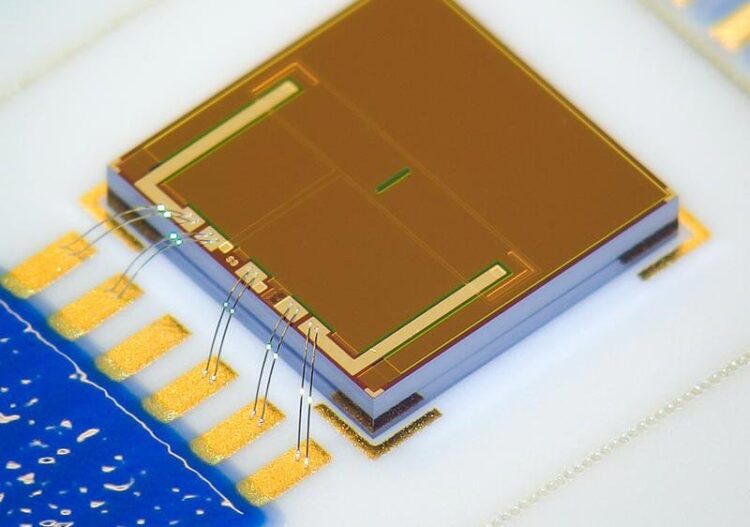Innovation in sensor technology

ISFET sensor chip from Fraunhofer IPMS
©Fraunhofer IPMS
Development of a new pH sensing layer successfully integrated into an ISFET.
Fraunhofer Institute for Photonic Microsystems IPMS announces a significant advance in chemical and biochemical analysis. The team led by Dr. Olaf R. Hild, Head of the Chemical Sensor Technology Business Unit, has successfully developed a pioneering sensing layer for chip-based pH measurement has and successfully integrated it into an ion-sensitive field-effect transistor (ISFET).

Simplified illustration of an ISFET with an Ag / AgCl reference electrode. © Fraunhofer IPMS
The pH of a solution is the most important parameter in chemical and biochemical analysis. An ISFET with a novel sensor layer developed by Fraunhofer IPMS, in combination with a conventional reference electrode, enables highly precise pH measurement in the range from pH 1 to pH 13. The compact, unbreakable sensor chip with dimensions of 5 x 5 mm² is characterized by a minimal drift of < 20 µV/h as well as low hysteresis while being easy to integrate. A significant improvement has also been achieved in the reduction of light sensitivity.
The dry storage capability of the sensor is one of its primary advantages. Moreover, the electrical operating point of the sensor can be flexibly adjusted via the design and the operating parameters, whereby an operating voltage (VDS) of below 1V is possible.
Dr. Hild, head of the research team, expressed his enthusiasm for the measurement data achieved by the mechanically robust sensor: “With these properties, the new ISFET is particularly suitable for on-site environmental analysis.” Dr. Hild went on to emphasize that the next important research goal is to develop a sensor layer that enables a purely chip-based pH measurement that eliminates the need for conventional reference electrodes. This breakthrough technology would then have the potential to continuously collect environmental data over long time periods without the need for intervention by operating personnel.
Physical principles of the ISFET from Fraunhofer IPMS
The novel ISFET from Fraunhofer IPMS is based on metal-oxide-semiconductor (MOS) field-effect transistor technology, whereby the sensor area in contact with the medium consists of an amphoteric metal oxide layer. Hydronium or hydroxide ions from the medium are reversibly adsorbed on this sensing layer, allowing for the pH of the medium to be measured. The gate-to-source voltage (VGS) response versus a reference electrode (Ag/AgCl in 3 M KCl) is then used as the measurement signal.
Some of the research results were achieved in the “REISen” project, a project from the Department of Materials Science, which was co-financed from tax funds on the basis of the budget approved by the Saxon state parliament.
The developments of Fraunhofer IPMS contribute significantly to the further development of environmental analysis and open up new possibilities for more precise and more efficient data acquisition in the field of chemical analysis.
About Fraunhofer IPMS
Fraunhofer IPMS is one of the leading international research and development service providers for electronic and photonic microsystems in the application fields of intelligent industrial solutions and manufacturing, medical technology and health, and mobility. In two state-of-the-art clean rooms and with a total of four development sites in Dresden, Cottbus and Erfurt, the institute develops innovative MEMS components and microelectronic devices on 200 mm and 300 mm wafers. Services range from consulting and process development to pilot production.
Wissenschaftliche Ansprechpartner:
Dr. Olaf Rüdiger Hild – olaf.hild@ipms.fraunhofer.de
Media Contact
All latest news from the category: Physics and Astronomy
This area deals with the fundamental laws and building blocks of nature and how they interact, the properties and the behavior of matter, and research into space and time and their structures.
innovations-report provides in-depth reports and articles on subjects such as astrophysics, laser technologies, nuclear, quantum, particle and solid-state physics, nanotechnologies, planetary research and findings (Mars, Venus) and developments related to the Hubble Telescope.
Newest articles

First-of-its-kind study uses remote sensing to monitor plastic debris in rivers and lakes
Remote sensing creates a cost-effective solution to monitoring plastic pollution. A first-of-its-kind study from researchers at the University of Minnesota Twin Cities shows how remote sensing can help monitor and…

Laser-based artificial neuron mimics nerve cell functions at lightning speed
With a processing speed a billion times faster than nature, chip-based laser neuron could help advance AI tasks such as pattern recognition and sequence prediction. Researchers have developed a laser-based…

Optimising the processing of plastic waste
Just one look in the yellow bin reveals a colourful jumble of different types of plastic. However, the purer and more uniform plastic waste is, the easier it is to…


